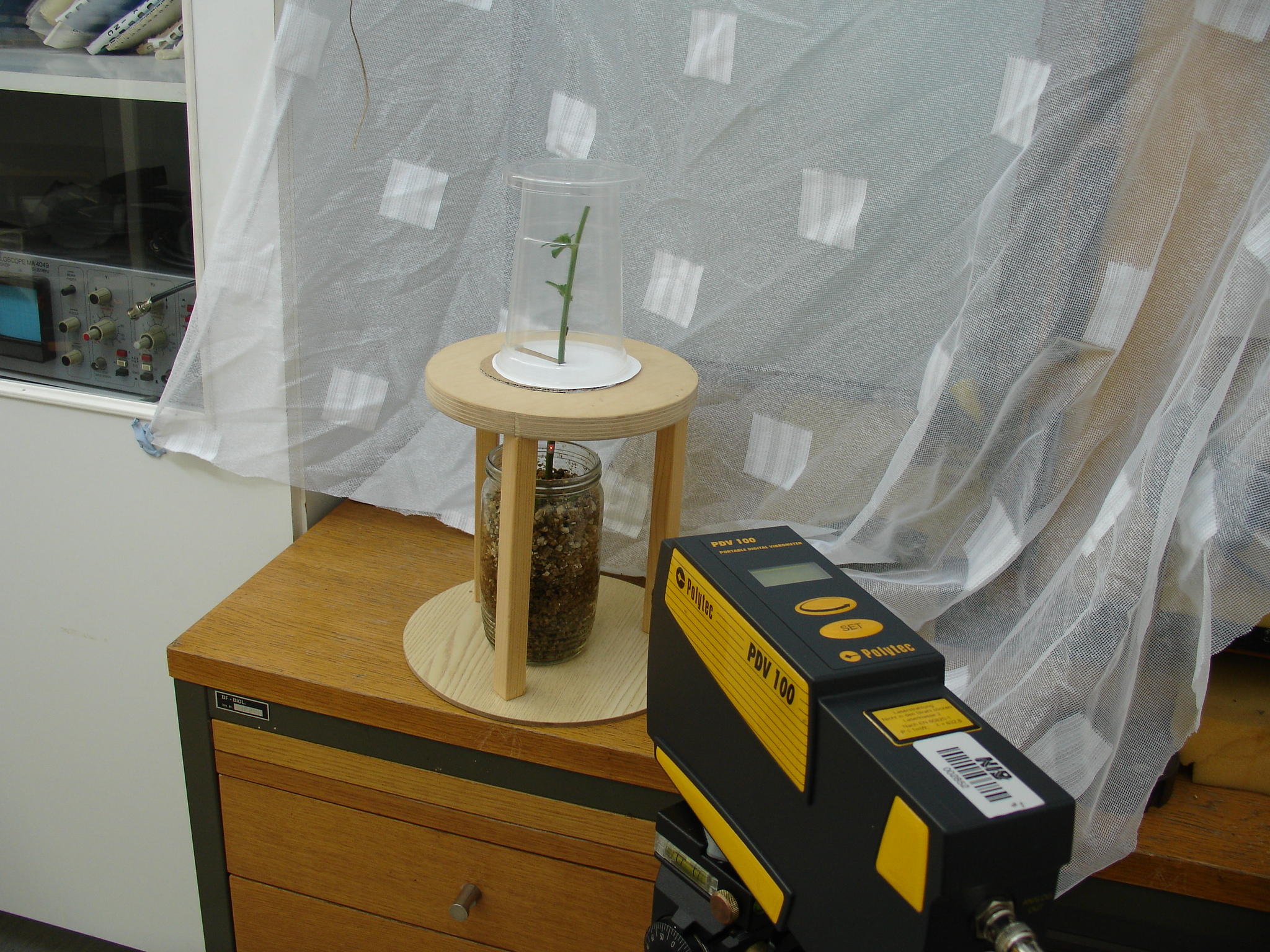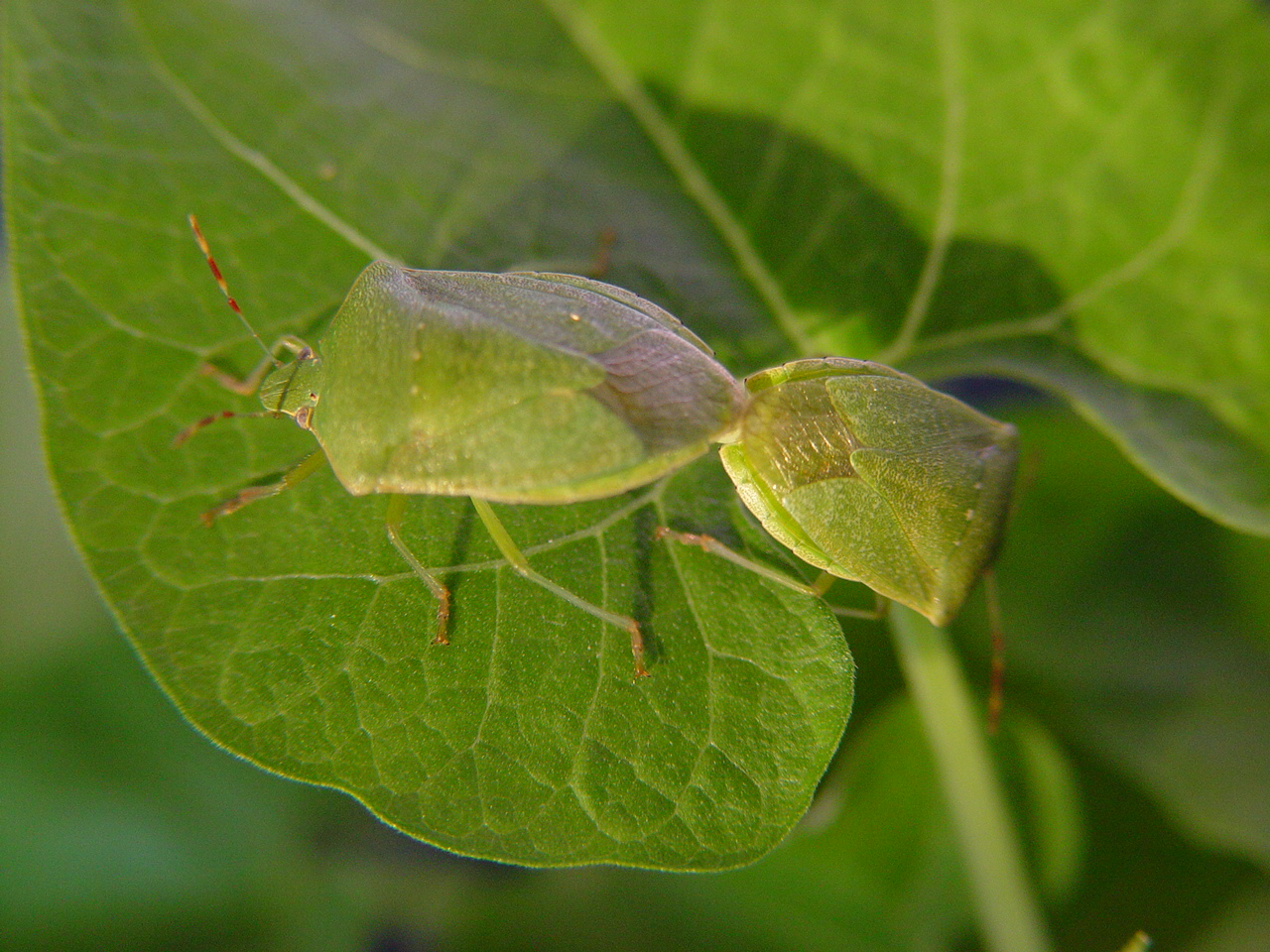
Andrej Cokl
– andrej.cokl@nib.si
Meta Virant-Doberlet – meta.virant@nib.si
Department of Entomology, National Institute of Biology
Vecna pot 111
SI-1000 Ljubljana, Slovenia
Popular version of paper 4aAB7
Presented Thursday morning, November 18, 2010
2nd Pan-American/Iberian Meeting on Acoustics, Cancun, Mexico
High-frequency airborne sound is quickly absorbed in vegetation, and outside the plant shelter such signals attract predators. Furthermore, small insects cannot efficiently emit low-frequency airborne sound when their diameter is smaller than a third of the radiated wavelength. For plant-dwelling insects, substrate-borne sound signaling remains the best solution for communication in dense vegetation typical for the tropics. Communication ranges in such an environment depend on tuning the properties of vibratory signals with the mechanical characteristics of plants, and on the insects' sensory abilities to extract the information from the environmental noise. Nezara viridula and other until now investigated species of the stink bug family Pentatomidae represent the model for optimizing long-range communication through green plants. They communicate with vibratory signals of the dominant frequency around 100 Hz, which travel through plants with low attenuation, creating standing wave conditions in the plant’s rod-like structures. Green plants act as low-pass filter, and their resonant peaks fit well with the spectral peaks of stink bug vibratory emissions. The species’ leg sensory organs and their underlying neural network are sensitive enough to enable communication through a plant on a distance of several meters. Comparative data on substrate-borne sound communication in burrower (Cydnidae) and predatory (Asopinae) bugs will be discussed.
Background. Species success depends significantly on localization and recognition of the partner in the field. In the three-dimensional world both complex tasks depend on communication defined as the process of information exchange via signals transmitted through different media like plants, soil, air, water and/or water surface. Each medium has different characteristics to which the emitter has to adapt its signals and the receiver its sensory organs with underlying neuronal networks to extract and process the information hidden in the environmental noise. On a long range scale insects communicate through the air by chemical and mechanical signals. When closer together on the same plant they employ signals of other modalities. Air transmitted chemical signals become less effective due to local air currents and different plant architectures, and airborne sound of higher frequencies is highly absorbed in the vegetation. In such a situation plant-dwelling insects have three possible solutions: high frequency (ultrasound) signals exchanged in the open air (acoustic free field), low frequency airborne signals or vibratory signals transmitted through the plant as plant- or substrate-borne signals. Communication in the open air outside the plant shelter is dangerous because intraspecific signals attract predators. Most insects are too small to emit efficiently low frequency airborne sound: for example a 1 cm sized insect efficiently emits airborne sound of frequencies above 10 kHz. Counting by species or families the majority of insects chooses substrate as the most suitable communication channel during calling, courting, rivalry or territoriality on a plant. In the paper we represent the main characteristics of substrate-borne sound communication in selected groups of plant-dwelling insects.
Methods. Development of non-contact (optical) laser based technology enabled investigations of basic phenomena occurring during transmission of insect emitted vibratory signals through plants or their parts which are too small and/or light to allow any loading by accelerometers or some other conventional contact sensors (FIGURE 1).

Figure 1. Recording
of the substrate-borne vibratory signals emitted by plant-dwelling insects by
the portable digital laser vibrometer.
In the paper we represent stinkbugs of the subfamily Pentatominae
(which emit signals by abdomen vibration), burrower bugs of the family Cydnidae (which stridulate) and predatory stinkbugs of the
subfamily Asopinae (which produce communication
signals using abdomen vibration, tremulation and
percussion). Signals were recorded from their host plants and from the
non-resonant loudspeaker membrane to evaluate the effect of the plant on
transmitted signal amplitude, time and frequency characteristics. Finally, we
show in pentatomide species Nezara
viridula the basic characteristics of the
structure and function of vibration sensitive receptors and of the ventral cord
higher order vibratory neurons, using of intracellular recording and staining
technique (FIGURE 2).

Figure 2. The southern green stinkbug Nezara viridula L. (Heteroptera: Pentatomidae).
Results. Substrate-borne sound communication signals of investigated stink and burrower bugs have species- and gender-specific time patterns which together with species-specific pheromones in most cases efficiently isolate species and prevent their hybridization (FIGURE 3).

Figure 3. Male and female vibratory emissions of the southern green stinkbug Nezara viridula.
Insects
use bending waves when communicating with plant-borne signals and are faced
with standing wave conditions in plants' rod-like structures, such as stem or
stalks. The green plants act as low pass filter that significantly attenuates
the vibrations of frequencies above 500 Hz and transmits most efficiently those
of the dominant frequencies around 100 Hz. Plant-transmitted low frequency
signals are prolonged due to low attenuation and echoes from phase borders. The
distance between the position of the nodes and antinodes in standing wave
conditions on a stem decreases with increasing frequency, which results in
different ratios of spectral peak amplitudes at different distances from the
vibration source. These basic characteristics of plants enable efficient long
range communication by signals produced by abdomen vibration and tremulation on one side and on the other restrict
information exchange by stridulation and percussion
to short distances where vision, contact chemical and/or mechanical signals of
other modalities become important as well. Stinkbug leg vibrational
receptor organs are most effective in the low frequency range and at least 17
different ventral cord higher order neurons form a network of ascending,
descending and local neuronal network processing the vibratory information
input.